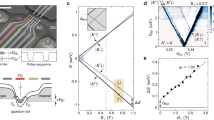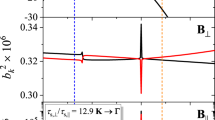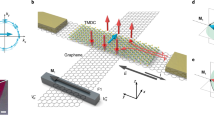Abstract
The prospect of transporting spin information over long distances in graphene, possible because of its small intrinsic spin–orbit coupling (SOC) and vanishing hyperfine interaction, has stimulated intense research exploring spintronics applications. However, measured spin relaxation times are orders of magnitude smaller than initially predicted, while the main physical process for spin dephasing and its charge-density and disorder dependences remain unconvincingly described by conventional mechanisms. Here, we unravel a spin relaxation mechanism for non-magnetic samples that follows from an entanglement between spin and pseudospin driven by random SOC, unique to graphene. The mixing between spin and pseudospin-related Berry’s phases results in fast spin dephasing even when approaching the ballistic limit, with increasing relaxation times away from the Dirac point, as observed experimentally. The SOC can be caused by adatoms, ripples or even the substrate, suggesting novel spin manipulation strategies based on the pseudospin degree of freedom.
This is a preview of subscription content, access via your institution
Access options
Subscribe to this journal
Receive 12 print issues and online access
$209.00 per year
only $17.42 per issue
Buy this article
- Purchase on Springer Link
- Instant access to full article PDF
Prices may be subject to local taxes which are calculated during checkout




Similar content being viewed by others
References
Castro Neto, A. H., Guinea, F., Peres, N. M. R., Novoselov, K. S. & Geim, A. K. The electronic properties of graphene. Rev. Mod. Phys. 81, 109–162 (2009).
Katsnelson, M. I., Novoselov, K. S. & Geim, A. K. Chiral tunnelling and the Klein paradox in graphene. Nature Phys. 2, 620–625 (2006).
McCann, E. et al. Weak localisation magnetoresistance and valley symmetry in graphene. Phys. Rev. Lett. 97, 146805 (2006).
Novoselov, K. S. et al. Room-temperature quantum Hall effect in graphene. Science 315, 1379 ( 2007).
Rycerz, A., Tworzydlo, J. & Beenakker, C. W. J. Valley filter and valley valve in graphene. Nature Phys. 3, 172–175 (2007).
San-Jose, P., Prada, E., McCann, E. & Schomerus, H. Pseudospin valve in bilayer graphene: Towards graphene-based pseudospintronics. Phys. Rev. Lett. 102, 247204 (2009).
Rashba, E. I. Graphene with structure-induced spin–orbit coupling: Spin-polarized states, spin zero modes, and quantum Hall effect. Phys. Rev. B 79, 161409 (2009).
Zutic, I., Fabian, J. & Das Sarma, S. Spintronics: Fundamentals and applications. Rev. Mod. Phys. 76, 323–410 (2004).
Jedema, F. J., Heersche, H. B., Filip, A. T., Baselmans, J. J. A. & van Wees, B. J. Electrical detection of spin precession in a metallic mesoscopic spin valve. Nature 416, 713–716 (2002).
Lou, X. et al. Electrical detection of spin transport in lateral ferromagnet–semiconductor devices. Nature Phys. 3, 197–202 (2007).
Avsar, A. et al. Towards wafer scale fabrication of graphene based spin valve devices. Nano Lett. 11, 2363–2368 (2011).
Han, W. & Kawakami, R. K. Spin relaxation in single-layer and bilayer graphene. Phys. Rev. Lett. 107, 047207 (2011).
Zomer, P. J., Guimaraes, M. H. D., Tombros, N. & van Wees, B. J. Long distance spin transport in high mobility graphene on hexagonal boron nitride. Phys. Rev. B 86, 161416(R) (2012).
Dlubak, B. et al. Highly efficient spin transport in epitaxial graphene on SiC. Nature Phys. 8, 557–561 (2012).
Ochoa, H., Castro Neto, A. H. & Guinea, F. Elliot-Yafet mechanism in graphene. Phys. Rev. Lett. 108, 206808 (2012).
Zhang, Z. & Wu, M. W. Electron spin relaxation in graphene with random Rashba field: Comparison of the Dyakonov-Perel’ and Elliot-Yafet-like mechanisms. New J. Phys. 14, 033015 (2012).
Tombros, N., Jozsa, C., Popinciuc, M., Jonkman, H. T. & van Wees, B. J. Electronic spin transport and spin precession in single graphene layers at room temperature. Nature 448, 571–574 (2007).
Min, H. et al. Intrinsic and Rashba spin–orbit interactions in graphene sheets. Phys. Rev. B 74, 165310 (2006).
Ertler, C., Konshush, S., Gmitra, M. & Fabian, J. Electron spin relaxation in graphene: The role of substrate. Phys. Rev. B 80, 045405(R) (2009).
Castro Neto, A. H. & Guinea, F. Impurity-induced spin–orbit coupling in graphene. Phys. Rev. Lett. 103, 026804 (2009).
Guimaraes, M. H. D. et al. Spin transport in high-quality suspended graphene device. Nano Lett. 12, 3512–3517 (2012).
Neumann, I. et al. Electrical detection of spin precession in freely suspended graphene spin valves on cross-linked poly(methyl methacrylate). Small 9, 156–160 (2013).
Dery, H. & Song, Y. Transport theory of monolayer transition-metal dichalcogenides through symmetry. Phys. Rev. Lett. 111, 026601 (2013).
Pi, K. et al. Manipulation of spin transport in graphene by surface chemical doping. Phys. Rev. Lett. 104, 187201 (2010).
Kochan, D., Gmitra, M. & Fabian, J. Spin relaxation mechanism in graphene: Resonant scattering by magnetic impurities. Phys. Rev. Lett. 112, 116602 (2014).
Roche, S. & Valenzuela, S. O. Graphene spintronics: Puzzling controversies and challenges for spin manipulation. J. Phys. D 47, 094011 (2014).
Weeks, C., Hu, J., Alicea, J., Franz, M. & Wu, R. Engineering a robust quantum spin Hall state in graphene via adatom deposition. Phys. Rev. X 1, 021001 (2011).
Dedkov, Y. S., Fonin, M., Rudiger, U. & Laubschat, C. Rashba effect in the graphene/Ni(111) system. Phys. Rev. Lett. 100, 107602 (2008).
Marchenko, D. et al. Giant Rashba splitting in graphene due to hybridization with gold. Nature Commun. 3, 1232 (2012).
Roche, S. et al. Quantum transport in disordered graphene: A theoretical perspective. Solid State Commun. 152, 1404–1410 (2012).
Nikolic, B. K. & Souma, S. Decoherence of transported spin in multichannel spin–orbit-coupled spintronic devices: Scattering approach to spin-density matrix from the ballistic to the localized regime. Phys. Rev. B 71, 195328 (2005).
Dery, H. et al. Nanospintronics based on magnetologic gates. IEEE Trans. Electron Devices 59, 259–262 (2012).
Foa Torres, L. E. F., Roche, S. & Charlier, J. C. Introduction to Graphene-Based Nanomaterials: From Electronic Structure to Quantum Transport (Cambridge Univ. Press, 2014).
Acknowledgements
We thank A. Cummings for a critical reading of the manuscript. The research leading to these results has received funding from the European Union Seventh Framework Programme under grant agreement number 604391 Graphene Flagship. This work was also funded by Spanish Ministry of Economy and Competitiveness under contracts MAT2012-33911 and MAT2010-18065. S.O.V. acknowledges ERC Grant agreement 308023 SPINBOUND.
Author information
Authors and Affiliations
Contributions
D.V.T., D.S. and F.O. designed the models and performed the calculations. D.V.T., F.O., S.O.V. and S.R. carried out analyses and interpretation. F.O., S.O.V. and S.R. wrote the text and all authors contributed to the manuscript and Supplementary Information.
Corresponding author
Ethics declarations
Competing interests
The authors declare no competing financial interests.
Supplementary information
Supplementary Information
Supplementary Information (PDF 762 kb)
Rights and permissions
About this article
Cite this article
Tuan, D., Ortmann, F., Soriano, D. et al. Pseudospin-driven spin relaxation mechanism in graphene. Nature Phys 10, 857–863 (2014). https://doi.org/10.1038/nphys3083
Received:
Accepted:
Published:
Issue Date:
DOI: https://doi.org/10.1038/nphys3083
This article is cited by
-
Magnetism, symmetry and spin transport in van der Waals layered systems
Nature Reviews Physics (2022)
-
Van der Waals heterostructures for spintronics and opto-spintronics
Nature Nanotechnology (2021)
-
Two-dimensional spintronics for low-power electronics
Nature Electronics (2019)
-
Determination of the spin-lifetime anisotropy in graphene using oblique spin precession
Nature Communications (2016)
-
Direct measurement of exciton valley coherence in monolayer WSe2
Nature Physics (2016)



